Film I: An Unexpected Journey
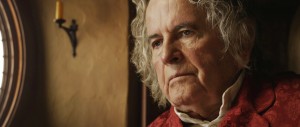
From the trailer, it seems clear that the first film will be set up as a ‘flashback’, with the plot device of old Bilbo writing his memoirs for Frodo at the time of the Birthday Party in the Fellowship of the Ring (FotR): ‘I told you about my adventures, but I may not have told you all of it’.
This device allows the narrative of the proposed Hobbit trilogy to potentially include everything up to the time of the LotR trilogy, and even possibly to include events contemporaneous with the end of Return of the King (RotK), such as the Battle of Dale, as in the book while Bilbo begins writing his book in Hobbiton, he tells Gandalf he wants to retire to Rivendell ‘to finish my book’.
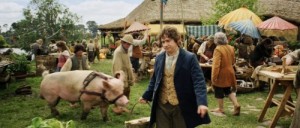
This is where the Dwarves begin to arrive. It makes sense for most of the Dwarves to not have been already introduced to the audience before they knock at the door, as this defeats the point of making their introductions at the door. However, a number of the Dwarves are shown in the video blogs falling through the door in a great heap, which suggests that these Dwarves may indeed have made some earlier appearance, perhaps in some scene of Gandalf negotiating with them on the way to Hobbiton.
Regardless, the Bag End scene is likely to be quite long, with flashbacks explaining:
- How Gandalf came across the key and map;
- The halcyon days of Erebor and Dale, to show what motivates the Dwarves to go on the Quest;
- How those dominions were laid waste by Smaug, to show what the quest must overcome if it is to be successful. (Smaug will likely only be shown in cameo, if at all, in these scenes).
However, one rumour is that the films will have a prologue, much like FotR. In this case, the likely prologue will be of the origins of the dragons in ancient history, and then the last two flashbacks outlined above from the Bag End scene, namely of the glory days of Dale and the coming of Smaug, and the driving out of the Dwarves. This may well show young Thorin, Balin and Dwalin escaping Smaug’s wrath.
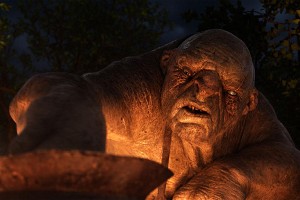
Once they have left Hobbiton, the film will have to show the journey to the Trollshaws. This journey raises one of the major challenges facing An Unexpected Journey, in that it will potentially trigger in the audience a sense of deja-vu, given that, like FotR, it progresses from Hobbiton, through the Trollshaws and Rivendell, to a descent beneath the Misty Mountains.
The likely best solution for this will be to focus on character development throughout this part of the adaptation, to distract from the repetition of locations.
But the director could also do what he sometimes did in the LotR trilogy: move certain scenes to different parts of the story. In particular, it is quite possible that he might have the Company pass through the Old Forest and the Barrow-downs on the way to Rivendell, perhaps passing Bree and Weathertop only at a distance, thereby using locations from the FotR book which were not included in the FotR film. He moved scenes in this way between the LotR films (for instance, Old Man Willow trapped the hobbits in Fangorn, rather than the Old Forest as happened in the book). Doing this would allow him to give a sense that the journey to the Trollshaws was arduous and fairly lengthy in itself, but without triggering FotR deja-vu.
In Tolkien’s world, the Barrow-downs – located east of the Shire, but west of Bree – are places where men of the north (Dunedain) were buried long ago. The Witch-king of Angmar (also the leader of the Nazgul/Black Riders) later sent evil spirits, called wights, to inhabit the barrows. In FotR, the four hobbits are trapped by these spirits in the Barrow-down mists before being rescued by Tom Bombadil.
What is likely to therefore happen is this: the Company will travel through the Barrow-downs on their way from Hobbiton to the Trollshaws, and become trapped in the same manner as the Hobbits in FotR. Gandalf will likely rescue them, instead of Tom Bombadil.
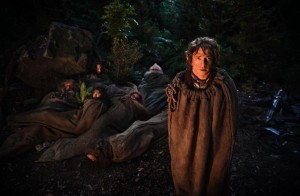
From a pacing perspective, including the Barrow-downs scene here would be a good addition to the Hobbit, as in the book basically nothing happens between leaving Hobbiton to arriving at the Trollshaws. Bear in mind this is roughly the same journey as taken by the Hobbits in FotR, but in that film they passed through farmland, the ferry, Bree, the Midgewater Marshes and Weathertop.
From the Hobbit soundtrack special edition tracklist, released on 1 November, we can see that there is a track entitled ‘An Ancient Enemy’ positioned between tracks that clearly pertain to the meeting at and setting out from Bag End and later the Trollshaws. The ancient evil is evidently the Nazgul, and by association Sauron, which corroborates the above theory that the Dwarves will pass through the Barrow-downs.
Interestingly, the next track, also before the Trollshaw theme, is entitled ‘Radagast the Brown’. This indicates that Radagast may join the Company at the Barrow-downs. According to reports on the footage presented at CinemaCon, there is a scene where Gandalf is exploring a crypt and is suddenly surprised by Radagast. This would fit with the theory that Radagast perhaps comes across the Company, and perhaps plays the role that Tom Bombadil played in FotR (the book) by releasing them from the wights.
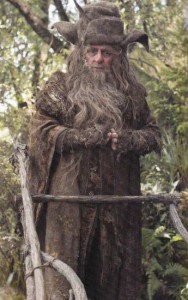
The second act will be the meat of the conflict that must be resolved in the story. The core of this conflict is the dwarves lack of faith, confidence and respect for Bilbo (bearing in mind that the heart of any drama is character). This is, of course, thrown into sharp relief under the pressure of the events that occur and the challenges they face: the incident with the trolls; the climb into the Misty Mountains during the storm; and the danger from Stone-giants; their capture by and escape from the Goblins; Bilbo meeting with and outwitting of Gollum.
First of all will clearly be the Trollshaws scene. Gandalf, remember, disappears shortly before the problem with the Trolls, and this is never explained in the book. But in the Soundtrack tracklist that has been released, following the Trollshaws and Troll cave scene, there is a track entitled ‘The Hill of Sorcery’. What this is remains a mystery, but it is likely that Gandalf and Radagast will have been exploring it while the Company are beset by the Trolls. From the hilltop, I would wager that Radagast receives news from the birds that trolls are about, and ‘looking behind’ from the top of the hill, Gandalf sees the Troll’s fire, and returns to rescue the Company.
From the tracklists, it would appear that the Company then have a run-in with ‘Warg-scouts’, as they struggle to locate Rivendell. This would make sense, as in the Hobbit video blogs the actors are shown running around shrub grassland, and the actors say they are fleeing Wargs. The landscape does not suit the narrative of the Company once they escape the Misty Mountains and get caught up trees, so it all makes sense if they are harried by Wargs between the Trollshaws and Rivendell.
My guess would be that the Company lead Wargs into the Hidden Valley itself, which prompts the elvish horsemen we have seen in the video blogs to probably rescue them, but also treat them with suspicion as they have come out of the wild unheralded.
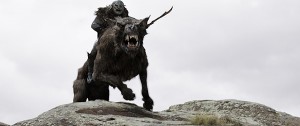
In Rivendell itself, beyond the explanation of the moon letters on the map of the secret door, there will then likely be the meeting of the White Council, to establish the broader problem of the Necromancer, which reveals Gandalf’s true interest in the Quest, and thus begins his story arc proper. As just argued, the White Council scene will pivot off a discussion of the Morgul-blade that Gandalf found in the Barrow-downs. The evidence of a power that can raise the Witch-king from his crypt indicates the involvement of the Necromancer (the name of course meaning one who can raise the dead).
Yet the Rivendell sequence would also provide an opportunity to establish through ‘flashback’ the bloody history of mutual hatred and conflict between the dwarves and goblins. This will likely happen when Elrond enlightens the Company on the origin of the swords they found in the trolls’ hoard.
In the book, he explains that they are famous blades that were used against the goblins in previous centuries. Indeed, although ancient and elvish in origin, these swords had previously been used by Dwarves at the Battle of Azanulbizar. Probably using a wide-eyed, questioning Bilbo as a device, there could here be historical flashbacks that reveal the depths of the hatred between the Dwarves and the Goblins: how Thorin’s ancestor Thror was killed and mutilated by Azog the Goblin, and the subsequent battle of Azanulbizar at the East Gate of Moria.
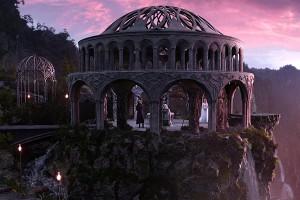
The soundtrack tracklist also has, between tracks entitled ‘Moon Runes’ and ‘The White Council’, a track called ‘The Defiler’, which of course was the name given Azog after he killed Thror.
This historical ‘flashback’ exposition would be perfectly timed to happen in Rivendell, as it ratchets up the dramatic tension as the Company begin their ascent into passes of the Misty Mountains, which results, of course, in their capture by Goblins. Thus this first act, terminating (such as in the FotR) in Rivendell, thereby provides the expository setup for both the rest of the first film and the whole Hobbit trilogy.
Following Rivendell, Jackson appears to have beefed up the scenes with the Stone-giants. Whether he will link this with some form of sorcery or necromancy will be interesting, because certainly the Stone-giants remain unexplained, and given the efforts the filmmakers are going to explain things that go unexplained in the book, it would be incongruous for them to neglect an explanation.
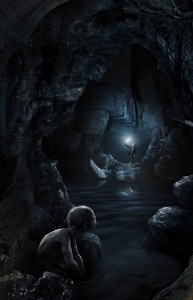
The third act will be the seeming resolution, with his reunion with the Dwarves, but then the attack of the wargs and the burning of the fir trees. It is likely in this scene that Azog will be revealed to be alive, just before the Company is rescued by the eagles. As per the book, following their escape from the Misty Mountains Thorin and Co. will be forced up trees and surrounded by a forward team of wargs and orcs as in the book (in the films, this pack will likely be led by Yazneg, to be played by John Rawls. Yazneg, a new character, apparently appears in two films, which suggests that he might then re-appear as a second-in-command to Azog at the Battle of the Five Armies). From the top of his tree, Thorin will be able to see orc reinforcements coming from all directions. Clearly all hope is lost.
But Thorin suddenly sees one great orc among them, entering the clearing below the trees. To his horror, it is clearly Azog, thought to be long dead (it is possible that Bifur will also recognise Azog, if he is written to have had the axe embedded in his head by Azog himself at Azanulbizar). Azog himself recognises Thorin. It is at this point that the eagles swoop down and rescue the company.
This fleeting introduction would allow for two things.
First, the shocking revelation that Azog is alive and well and in command of a large force. This will appear as no coincidence to Gandalf, given the revelation that the Witch-king has been released from his tomb, suggests that both have possibly been ‘necromanced’ back from the dead, or at any rate mobilised by some greater power. One can just imagine the dialogue between Thorin and Gandalf following this close encounter with Azog:
Thorin: ‘But I saw him die over a century ago! How is he alive?’
Gandalf: ‘Much that was once certain is no longer. The world is growing stranger with the seasons. This is not the most concerning omen of our journey, only the most recent. The dead walk abroad, and I must go to Dol Guldur. There is a power at work, a dark power. Necromancy serves a purpose, and one greater than purely to inconvenience you, Thorin.’
Thus this scene would allow Gandalf to discover the connection between Azog and Dol Guldur, setting the scene for his break south from the Company when they reach Mirkwood.
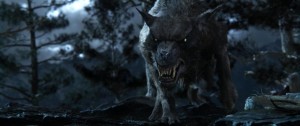
The film will therefore likely end with the Eagles rescuing the Company, and bearing them to their aerie, from which we might then glimpse a view eastwards, to Mirkwood.
Thus the first film being titled ‘An Unexpected Journey’: Thorin as an exile trying to band together a disparate group of dwarves on a quest; Gandalf realising what is at stake and convincing the White Council of the need for action; and the dramatic heart will be of Bilbo’s journey from Bag End to burglar, and his struggle to gain the respect of the dwarves and to ‘find his courage’, something he will likely tell Gandalf from the eagles’ aerie, as they look out towards Mirkwood, and Bilbo fingers the ring in his pocket, a scene that will remind us of the deeper evil at work.


